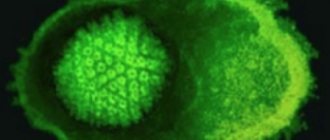Save the article:
The most dangerous fatal viral disease is called rabies and affects the nervous system. When a cat hears the phrase rabies, it immediately associates it with aggressive behavior, attacks, and uncontrollable reactions of the animal. Well, sometimes the behavior of your beloved cat changes dramatically and resembles a wild and unbridled beast. But this is only one of the forms of a viral disease; sometimes it is not immediately possible to recognize the disease by the quiet behavior of a domestic cat, which is actually very scary: rabies is contagious and dangerous not only for all pets, but also for humans. Serious damage to the nervous system without treatment quickly leads to the death of the patient.
It is worth figuring out whether rabies in cats can be prevented, and what to do if the virus enters the animal’s body.
What is rabies in humans?
The disease is caused by a pathogen from the rhabdovirus family.
When bitten by a sick animal, it quickly penetrates the brain cells, causing inflammation. Hunters, foresters and people of other professions associated with being in the wild suffer especially often. There are also urban centers of the disease, so you should not go close to stray dogs and cats. When visiting the forest, you need to remember that healthy wild animals are afraid of people. If an animal, for example a fox, comes out to people or enters villages, it almost certainly has rabies.
As soon as rabies is suspected, the patient must be hospitalized immediately. The rabies virus causes a fatal form of the disease in humans.
How can an animal become infected?
Rabies is a deadly cat disease.
Infection of a pet can occur either after direct contact with a sick animal or by eating an infected rodent.
At the same time, not only stray cats, but also representatives of wild nature are carriers of rabies. Also, the danger of infection comes from mice, birds and rats.
Rabiologists identify 3 methods of transmission of infection:
- Aerosol path. Recent studies have shown that the rabies virus is contained in gas vapors released from the body of an infected dead animal.
- Bite of a sick individual.
- Contact with infected saliva on the mucous membrane or in an open wound.
From the entry of a viral infection into the body to the appearance of the first symptoms, it usually takes from 3 to 14 days.
The misconception that you can “bring” rabies home on your shoes or outerwear
But in practice there are cases when the latent period lasted 2 months.
The rate at which rabies spreads throughout the body depends on:
- method and place of infection;
- the state of the pet's immune system;
- the amount of infection that has entered the body.
Important! It is a misconception that you can “bring” rabies home on your shoes or outerwear. A dangerous virus dies upon contact with the external environment.
Causes of rabies in humans
The cause of the disease can be either a bite or contact with the saliva of a sick animal on the skin. In nature, the virus circulates among foxes, wolves, dogs, cats, bats, horses, sheep, cows and many other animal carriers.
Medical personnel can become infected from a patient if his saliva, tear fluid or other secretions come into contact with damaged skin or mucous membranes. Therefore, you can only work with such patients in a protective suit and mask.
How does a cat become infected to a person?
The routes of infection in humans are similar to the types of infection in cats.
The rabies virus is transmitted to humans through:
- Bites . Squeezing the skin, when the animal’s teeth even slightly injure the skin, allows the pathogen to penetrate the human body.
- Scratches . Cats are clean animals that constantly lick themselves. A pet, after licking its paws, can scratch its owner and thus transmit a dangerous virus to him.
- Saliva entering the mucous membrane . Owners love to kiss their cats. As a result, the saliva of an infected animal can easily enter the human body.
Information! The closer the site of infection is to the head, the faster the virus enters the body and develops more actively in it.
Symptoms and signs of rabies in humans
The incubation period for rabies ranges from 1 to 3 months, but sometimes it lasts less than a week or even more than a year. At this time the person feels healthy.
Symptoms of rabies depend on the stage of the disease. The onset of the disease is gradual. The patient is concerned about itching of the skin at the site of the bite, pain spreading along the nerves. Headache, anxiety, irritability, fear, and insomnia appear. The temperature rises, the patient does not tolerate sounds and bright light, the appetite worsens, and hydrophobia develops - the inability to swallow water.
During the peak period, the following signs of rabies in humans are observed:
- seizures;
- profuse drooling and heavy sweating;
- severe dehydration;
- agitation and hallucinations, delusions, violent behavior.
Then rabies in humans leads to the development of paralysis of various muscles, including respiratory muscles, which ultimately leads to death.
Forms of the disease, first signs
The main reason why it has not yet been possible to defeat rabies is the impossibility of its early diagnosis.
The disease has 4 forms: abortive, violent, atypical and paralytic.
In addition, its symptoms are similar to those of other ailments. Most often, an accurate diagnosis can be established only after an autopsy of the deceased animal.
Before death occurs, the doctor makes a preliminary conclusion based only on the external signs of the disease.
Features of the silent paralytic form of rabies
The paralytic type of the disease is less common than other forms of the disease.
Be sure to read:
What diseases can you get from a cat: 11 infections dangerous to humans
A characteristic feature of this type of rabies is the mild manifestation of symptoms or their complete absence.
Paralytic rabies is less common than other forms of the disease.
To establish a diagnosis, close observation of the cat is required.
The owner should sound the alarm if the pet has:
- Change in behavior . For example, unaffectionate cats require increased attention, or a curious animal suddenly becomes aloof and does not show attention to anything.
- Profuse salivation . Increased salivation is caused by the rabies virus infecting the muscles of the lower jaw, causing paralysis.
- Immobilization of individual parts of the body . In cats with a silent form of the disease, it is mainly the front or hind legs that fail.
- Constant coughing . Owners often associate coughing attacks with a foreign object getting into the animal’s throat. In fact, persistent coughing is often caused by the rabies virus, which causes paralysis of the laryngeal muscles.
In addition, with the paralytic form of the disease, the animal experiences photophobia and diarrhea. 2–3 days after loss of motor activity, the infected individual dies.
Furious rabies is the most dangerous form
When the disease progresses aggressively, the infected individual experiences:
- Sudden change of mood . The animal becomes aggressive. May attack the owner for no reason.
- Excessive self-care . An infected individual constantly licks its fur.
- Loss of appetite . Many sick animals refuse to eat food and water.
- Digestive disorder . The rabies virus causes vomiting and diarrhea. Often there is a bloody admixture in the contents of the intestines and stomach.
- Neurological abnormalities . An infected cat exhibits tremors in the limbs, constant tilting of the head, and convulsions. The animal's gait becomes unsteady.
3-4 days after infection, other symptoms are added to the first signs of the disease. For example, an infected individual begins to eat things unsuitable for food.
Furious rabies is the most dangerous form
The death of the animal, depending on the strength of the immune system, occurs after 5–7 days from cardiac arrest or exhaustion.
Atypical
This type of rabies is the most difficult to diagnose. Determining the presence of the disease is difficult, since a dangerous illness also manifests itself as an eating disorder.
The only signs of an infectious disease are vomiting and diarrhea with blood clots.
The atypical form of rabies poses a particular danger to humans, since infection occurs not only when interacting with a sick animal, but also when cleaning its toilet.
Be sure to read:
Colds in cats: symptoms and treatment, causes of the disease, how to determine whether it is transmitted to humans
This form of the disease is characterized by a long course of the disease. In this case, the death of the animal after infection occurs only after 40–50 days.
Abortive
This type of rabies is the least studied because it is very rare. The abortive form of the disease is characterized by a sharp recovery of the infected individual.
In terms of symptoms, the disease is similar to the silent form of rabies, but when signs of paralysis appear, the symptoms of the disease suddenly disappear.
However, after 2 weeks the disease may return, and then the disease progresses more rapidly: death occurs in 2–4 days.
Diagnosis of rabies in humans
The diagnosis is made clinically, based on characteristic symptoms and medical history (animal bite). An analysis of the cerebrospinal fluid is prescribed, in which a slight increase in protein concentration and the number of lymphocytes is noted.
Additional diagnostic methods:
- virological study by infecting newborn mice with sick biomaterial;
- PCR is the most accurate rabies test for detecting genetic viral material;
- determination of virus antigen and antibodies by enzyme immunoassay.
Blood tests look for signs of dehydration, and a chest X-ray may reveal pneumonia.
Treatment of rabies in humans
There is no drug that destroys this virus. Therefore, treatment of rabies is symptomatic, designed only to improve the patient’s condition. Whether he survives or not depends on the severity of the disease and the condition of the body.
The patient is placed in a dark, quiet room, a tracheostomy is performed, a urinary catheter is inserted, and tube feeding is established. The following groups of medications are used:
- anticonvulsants and sedatives;
- supporting heart function;
- replenishing the volume of fluid in the blood and eliminating intoxication.
If necessary, artificial ventilation is performed.
Prevention of rabies
With timely medical care, the disease will not develop.
Prevention of rabies in humans includes primary immunization and post-exposure prophylaxis. Rabies vaccination is given to healthy people of certain professions - veterinarians, hunters, foresters, taxidermists, dog catchers. For this purpose, an anti-rabies vaccine is used.
Post-exposure prophylaxis – measures after a bite or saliva of a sick animal gets on damaged human skin:
- immediately wash the wound with water and soap for 15 minutes, then treat with 70% alcohol;
- All victims are given a rabies vaccine.
In addition, some groups of patients are given anti-rabies injections containing rabies immunoglobulin. These are specific antibodies that immediately begin to resist the pathogen that enters the blood. Immunoglobulin is administered for percutaneous bites or scratches, contact with saliva of damaged skin or mucous membranes, as well as for injuries received from bats. If the skin is not bitten, there are only small scratches, then such immunoglobulin is administered only to patients with immunodeficiency.
Vaccinated patients also receive injections after an animal bite, but their dosage and quantity are reduced in accordance with the instructions.
What to do if your pet is sick?
The only correct choice is to euthanize the infected individual. There are no medications or treatments in veterinary medicine that can treat rabies in cats.
The risk of contracting a dangerous disease is great not only for other animals, but also for the owner. By putting your pet to sleep, you will be able to prevent further transmission of the infection and save your pet from inevitable suffering.
The risk of contracting rabies is high not only for other animals, but also for the owner
Why should you contact the Mama Papa Ya clinic?
The network of family clinics “Mama Papa Ya”, whose branches are located in different districts of Moscow, provides services for the prevention of rabies through vaccination. To get vaccinated, you need to make an appointment with a therapist or pediatrician, and then get an injection there. Advantages of our clinic:
detailed consultation with a specialist before vaccination;
- the opportunity to visit an allergist for relevant diseases;
- various laboratory diagnostics;
- affordable prices and no queues.
For more detailed information, make an appointment with a specialist by phone or on our website.
Reviews
Good clinic, good doctor!
Raisa Vasilievna can clearly and clearly explain what the problem is. If something is wrong, she speaks about everything directly, not in a veiled way, as other doctors sometimes do. I don’t regret that I ended up with her. Anna
I would like to express my gratitude to the staff of the clinic: Mom, Dad, and me. The clinic has a very friendly atmosphere, a very friendly and cheerful team and highly qualified specialists. Thank you very much! I wish your clinic prosperity.
Anonymous user
Today I had a mole removed on my face from dermatologist I.A. Kodareva. The doctor is very neat! Correct! Thanks a lot! Administrator Yulia Borshchevskaya is friendly and accurately fulfills her duties.
Belova E.M.
Today I was treated at the clinic, I was satisfied with the staff, as well as the gynecologist. Everyone treats patients with respect and attention. Many thanks to them and continued prosperity.
Anonymous user
The Mama Papa Ya clinic in Lyubertsy is very good. The team is friendly and responsive. I recommend this clinic to all my friends. Thanks to all doctors and administrators. I wish the clinic prosperity and many adequate clients.
Iratyev V.V.
We visited the “Mama Papa Ya” Clinic with our child. A consultation with a pediatric cardiologist was needed. I liked the clinic. Good service, doctors. There was no queue, everything was the same price.
Evgeniya
I liked the first visit. They examined me carefully, prescribed additional examinations, and gave me good recommendations. I will continue treatment further; I liked the conditions at the clinic.
Christina
The doctor carefully examined my husband, prescribed an ECG and made a preliminary diagnosis. She gave recommendations on our situation and ordered additional examination. No comments so far. Financial agreements have been met.
Marina Petrovna
I really liked the clinic. Helpful staff. I had an appointment with gynecologist E.A. Mikhailova. I was satisfied, there are more such doctors. Thank you!!!
Olga











